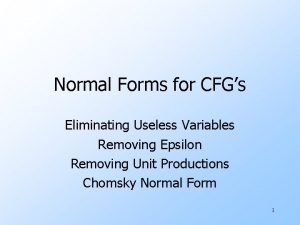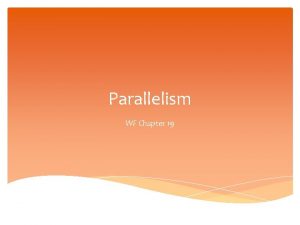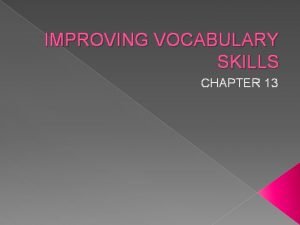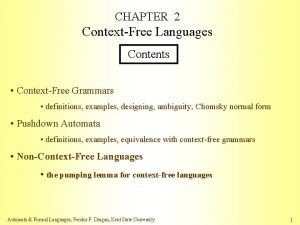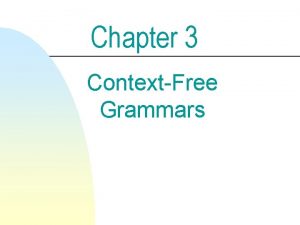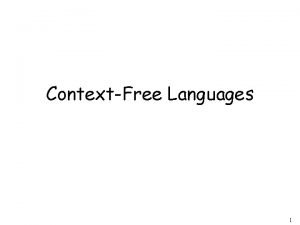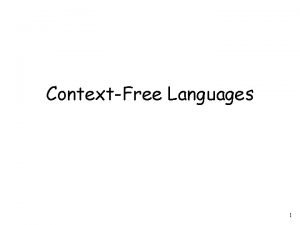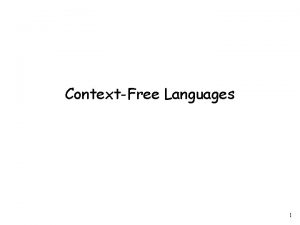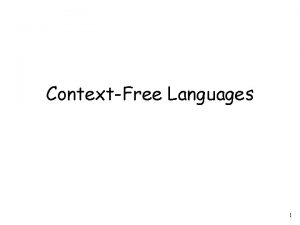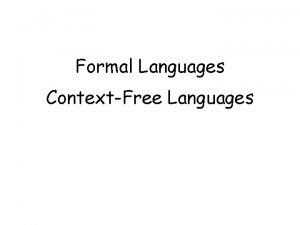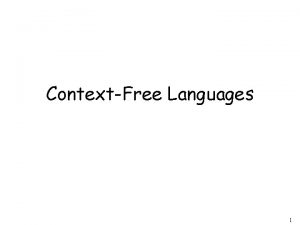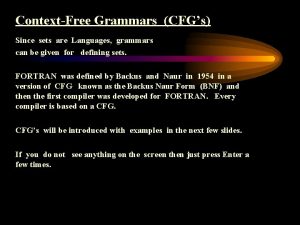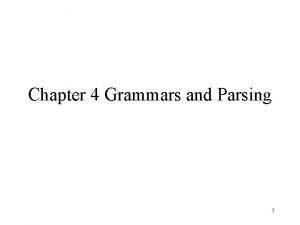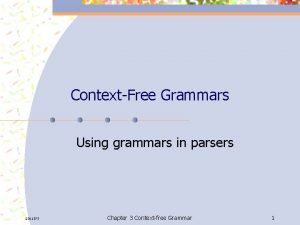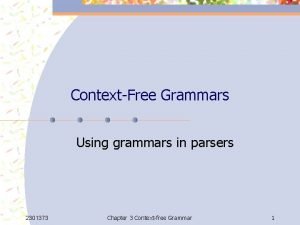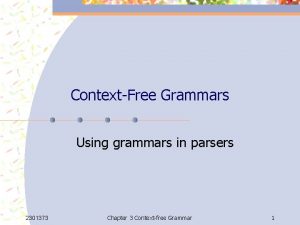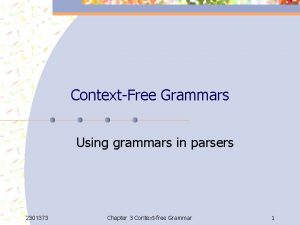CHAPTER 2 ContextFree Languages Contents ContextFree Grammars definitions
















- Slides: 16

CHAPTER 2 Context-Free Languages Contents • Context-Free Grammars • definitions, examples, designing, ambiguity, Chomsky normal form • Pushdown Automata • definitions, examples, equivalence with context-free grammars • Non-Context-Free Languages • the pumping lemma for context-free languages Theory of Computation, Feodor F. Dragan, Kent State University 1

Pushdown Automata (PDAs) • A new type of computational model. • It is like a NFA but has an extra component called stack. • The stack provides additional memory beyond the finite amount available in the control. • The stack allows pushdown automata to recognize some non-regular languages. • Pushdown automata are equivalent in power to context-free grammars. State control a a b b input Schematic of a finite automaton x y z … State control a a b b stack input Schematic of a pushdown automaton • A PDA can write symbols on stack and read them back later • Writing a symbol is pushing, removing a symbol is popping • Access to the stack, for both reading and writing, may be done only at the top (last in, first out) • A stack is valuable because it can hold an unlimited amount of information. Theory of Computation, Feodor F. Dragan, Kent State University 2

Example • Consider the language • Finite automaton is unable to recognize this language. • A PDA is able to do this. Informal description how the PDA for this language works. • Read symbols from the input. • As each 0 is read, push it into the stack. • As soon as 1 s are seen, pop a 0 off the stack for each 1 read. • If reading the input is finished exactly when the stack becomes empty of 0 s, accept the input. • If the stack becomes empty while 1 s remain or if the 1 s are finished while the stack still contains 0 s or if any 0 s appear in the input following 1 s, reject the input. Theory of Computation, Feodor F. Dragan, Kent State University 3

Formal Definition of PDAs • A pushdown automaton (PDA) is specified by a 6 -tuple , where is a finite set of states, is a finite input alphabet, is a finite stack alphabet, is the transition function, is the initial state, is the set of final states. Non-deterministic Is a collection of all subsets • It computes as follows: it accepts input w if w can be written as where each and a sequence of states and strings exist that satisfy the next three conditions (the strings represent the sequence of stack contents that PDA has on the accepting branch of the computation. Theory of Computation, Feodor F. Dragan, Kent State University 4

Example • Consider the language Input: Stack: 0 0 $ q 1 q 2 q 3 q 4 1 0 $ {(q 2, 0)} {(q 3, )} 0 $ {(q 2, $)} {(q 4, )} : when the machine is reading an a from the input it may replace the symbol b on the top of stack with a c. Any of a, b, and c may be . a is , the machine may take this transition without reading any input symbol. b is , the machine may take this transition without reading and popping any stack symbol. c is , the machine does not write any symbol on the stack when going along this transition. q 1 q 2 Theory of Computation, Feodor F. Dragan, Kent State University q 3 q 4 5

More Examples • Language q 1 q 2 q 5 q 3 q 6 q 4 q 7 • Language q 1 q 2 Theory of Computation, Feodor F. Dragan, Kent State University q 3 q 4 6

Equivalence with Context-free Grammars • Context-free grammars and pushdown automata are equivalent in their descriptive power. Both describe the class of context-free languages. • Any context-free grammar can be converted into a pushdown automaton that recognizes the same language, and vice versa. • We will prove the following result Theorem. A language is context-free if and only if some pushdown automaton recognizes it. • This theorem has two directions. We state each direction as a separate lemma. Lemma 1. If a language is context-free, then some pushdown automaton recognizes it. • We have a context-free grammar G describing the context-free language L. • We show to convert G into an equivalent PDA P. • The PDA P will accept string w iff G generates w, i. e. , if there is a leftmost derivation for w. • Recall that a derivation is simply the sequence of substitution made as a grammar generates a string. Theory of Computation, Feodor F. Dragan, Kent State University 7

How do we check that G generates 0110011 ? Promising variants Idea • We can use stack to store an intermediate string of variables and terminals. • It is better to keep only part (suffix) of the intermediate string, the symbols starting with the first variable. • Any terminal symbols appearing before the first variable are matched immediately with symbols in the input string. • Use non-determinism, make copies. Theory of Computation, Feodor F. Dragan, Kent State University 8

Informal description of PDA P 1. 2. Place the marker symbol $ and the start symbol on the stack. Repeat the following steps forever. a) If top of stack is a variable symbol A, non-deterministically select one of the rules for A and substitute A by the string on the right-hand side of the rule. b) If the top of stack is terminal symbol a, read the next symbol from the input and compare it to a. If they match, pop a and repeat. If they do not match, reject on this branch of the non-determinism. c) If the top of the stack is the symbol $, enter the accept state. Doing so accepts the input if it has all been read. Theory of Computation, Feodor F. Dragan, Kent State University 9

Construction of PDA P String of terminals and variables For |w|>1 use extensions Theory of Computation, Feodor F. Dragan, Kent State University 10

Example Theory of Computation, Feodor F. Dragan, Kent State University 11

Equivalence with Context-free Grammars • We are working on the proof of the following result Theorem. A language is context-free if and only if some pushdown automaton recognizes it. • We have proved Lemma 1. If a language is context-free, then some pushdown automaton recognizes it. • We have shown how to convert a given CFG G into an equivalent PDA P. • Now we will consider the other direction Lemma 2. If a pushdown automaton recognizes some language, then it is context-free. • We have a PDA P, and want to create a CFG G that generates all strings that P accepts. • That is G should generate a string if that string causes the PDA to go from its start state to an accept state (takes P from start state to an accept state). Theory of Computation, Feodor F. Dragan, Kent State University 12

Example q 1 q 2 • string 000111 takes P from start state to a finite state; • string 00011 does not. q 4 q 3 Design a Grammar • Let P be an arbitrary PDA. • For each pair of states p and q in P the grammar will contain a variable • This variable will generate all strings that can take P from state p with empty stack to q with an empty stack • Clearly, all those strings can also take P from p to q, regardless of the stack contents at p, leaving the stack at q in the same condition as it was at p. Theory of Computation, Feodor F. Dragan, Kent State University 13

Design a Grammar (cont. ) First we modify P slightly to give it the following three features. 1. It has a single accept state, . . . . 2. It empties its stack before accepting. 3. Each transition either pushes a symbol onto stack (a push move) or pops one off the stack (a pop move), but does not do both at the same time. q 1 q 2 Theory of Computation, Feodor F. Dragan, Kent State University 14

Design a Grammar (ideas) • • For any string x that take P from p to q, starting and ending with an empty stack, P’s first move on x must be a push; the last move on x must be a pop. (Why? ) If the symbol pushed at the beginning is the symbol popped at the end, the stack is empty only at the beginning and the end of P’s computation on x. • We simulate this by the rule , where a is the input symbol read at the first move, b is the symbol read at the last move, r is the state following p, and s the state preceding q. r s p • q Else, the initially pushed symbol must get popped at some point before the end of x, and thus the stack becomes empty at this point. • We simulate this by the rule becomes empty. , r is the state when the stack p r Theory of Computation, Feodor F. Dragan, Kent State University q 15

Formal Design • • Let We construct G as follows. • • • The variables are The start variable is Rules: • For each p, q, r, s from Q, , r . . . p put the rule • • s q in G. For each p, q, r from Q, , put the rule For each p from Q, , put the rule Theory of Computation, Feodor F. Dragan, Kent State University if we have in G. 16
 Every linear grammar generates a regular language
Every linear grammar generates a regular language What is unrestricted grammar
What is unrestricted grammar Questions on context free grammar
Questions on context free grammar Remove epsilon productions
Remove epsilon productions Chomsky hierarchy of grammars
Chomsky hierarchy of grammars Parallelism for paired ideas
Parallelism for paired ideas Sentence check 2 chapter 13
Sentence check 2 chapter 13 Define career portfolio
Define career portfolio Deep perineal pouch contents
Deep perineal pouch contents Fresh frozen plasma contents
Fresh frozen plasma contents Fresh frozen plasma vs platelets
Fresh frozen plasma vs platelets Endothoracic fascia
Endothoracic fascia Knee blood supply
Knee blood supply Horizontal
Horizontal The immortal life of henrietta lacks table of contents
The immortal life of henrietta lacks table of contents Medial lemniscus
Medial lemniscus Intermuscular spaces of scapular region
Intermuscular spaces of scapular region



